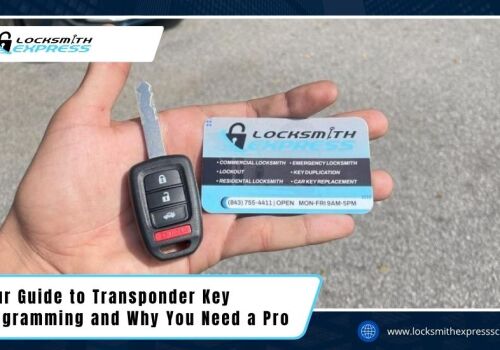Discovering a broken key stuck in your lock can be a frustrating experience, especially when you're in a hurry or facing bad weather. Whether you're a homeowner or renter, knowing how to remove a broken key from a lock safely can save you time, money, and stress. In this guide, we'll walk you through simple, step-by-step methods to help you get the broken key out without causing further damage to the lock mechanism.
- Why Keys Break Inside Locks
- Step-by-Step: How to Remove a Broken Key from a Lock
- Step 1: Assess the Situation
- Step 2: Gather the Tools You Might Need
- Step 3: Apply Lubricant to the Lock
- Step 4: Try Pliers or Tweezers First
- Step 5: Use a Paperclip or Bobby Pin
- Step 6: Use a Small Saw Blade
- Step 7: Try a Strong Magnet
- When to Call a Professional
- How to Prevent This in the Future
- Simple Tips to Keep Your Locks and Keys in Good Shape
- Frequently Asked Questions
- How do you get a broken key out of a lock at home?
- What tools can remove a broken key from a lock?
- Can you remove a broken key without tools?
- Is it safe to use WD-40 to remove a broken key?
- What should I do if the key broke off deep inside the lock?
Why Keys Break Inside Locks
Keys can break inside locks for several reasons, often when we least expect it. Over time, metal keys wear down and become weak, especially if they're used frequently or made from softer materials. Turning a key too forcefully, using it on a sticky or poorly maintained lock, or operating it at an angle can all lead to breakage. Understanding what causes a key to snap can help you avoid future problems and recognize when to replace or maintain your lock.
Step-by-Step: How to Remove a Broken Key from a Lock
Removing a broken key might seem stressful, but you can often solve the problem with the right approach. This step-by-step guide walks you through simple, practical methods to safely remove a broken key from a lock without damaging it. These techniques use everyday tools to help homeowners and renters handle the situation quickly and effectively.
Step 1: Assess the Situation
Before attempting removal, it's essential to understand how much of the key is visible. If part of the broken key sticks out of the lock, you have a better chance of removing it without tools. But if it's stuck inside, you'll need to be extra careful not to push it further. Inspecting the key's position will help determine the safest method to try first.
Step 2: Gather the Tools You Might Need
Removing a broken key can usually be done with standard household tools, especially if the key is only partially stuck. The deeper the key is lodged, the more precise your tools will need to be. Preparing can make the process smoother and reduce the risk of damaging the lock or pushing the key further inside. Here's a short list of what may help:
- Needle-nose pliers
- Tweezers
- Paperclips or bobby pins
- Lubricant (WD-40 or graphite powder)
- Small jigsaw or hacksaw blade
- Strong magnet
Having these tools ready before you start can save you time and help avoid further damage to the lock.
Step 3: Apply Lubricant to the Lock
Lubricant helps reduce friction inside the lock, making it easier for the key to slide out. Spray a small amount of WD-40 or graphite powder into the keyhole. Let it sit for a minute or two before using any tool. This step often makes a big difference, especially with older or rusty locks.
Step 4: Try Pliers or Tweezers First
If you can see and grab the broken piece, use needle-nose pliers or tweezers. Grip the key as close to the lock as possible and pull straight out. Avoid twisting, which could break the key further or damage the lock mechanism. A steady and slow pull works best here.
Step 5: Use a Paperclip or Bobby Pin
If the broken piece is just inside the lock, straighten a paperclip or bobby pin and insert it alongside the key. Try to hook one of the grooves on the key. Pull gently and slowly. This may take several tries, but patience and a steady hand can work well.
Step 6: Use a Small Saw Blade
Take a jigsaw or hacksaw blade with small teeth. Insert it into the keyway with the serrated edge facing the broken key. Gently jiggle and pull to catch the edge of the key and slide it out. Don't force it, as too much pressure could harm the lock.
Step 7: Try a Strong Magnet
This method works best if the key is made of metal that responds to magnets. Use a strong magnet by holding it at the keyhole to pull the broken piece out. It's a gentle method that may work, especially if the key is near the surface.
When to Call a Professional
If none of the methods work or you're worried about damaging the lock, it's time to call a professional locksmith. A licensed locksmith has the tools and experience to remove the broken key without harming the lock. Trying too many DIY methods can lead to more costly repairs. Calling an expert is the best way to protect your lock and ensure you regain access quickly and safely.
How to Prevent This in the Future
Preventing a key from breaking in the first place is the best approach. Here are a few tips to help:
- Replace keys that show signs of wear or cracking.
- Don't use force if a key is hard to turn.
- Lubricate your locks at least once a year.
- Get spare keys made before originals get too worn.
A little maintenance can go a long way. If your locks seem sticky or your key feels weak, it might be time to call for an inspection or key replacement.
Simple Tips to Keep Your Locks and Keys in Good Shape
Knowing how to remove a broken key from a lock can help you avoid damaging your lock and save money. Always check your keys for wear and keep locks maintained. If you cannot remove the key safely, contact a professional locksmith. Locksmith Express is ready to help secure your home with fast, reliable service.
Frequently Asked Questions
How do you get a broken key out of a lock at home?
Use needle-nose pliers to grab the visible part of the broken key. If it's not visible, try inserting a paperclip or blade to hook and slide it out carefully without damaging the lock.
What tools can remove a broken key from a lock?
Common tools include needle-nose pliers, tweezers, paperclips, jigsaw blades, and lubricants like WD-40 or graphite. These help grip or loosen the broken key from the lock.
Can you remove a broken key without tools?
If part of the key is sticking out, you may be able to pull it out with your fingers gently. Tools will likely be necessary for safe removal if it's flush or deeper inside.
Is it safe to use WD-40 to remove a broken key?
Yes, spraying WD-40 or a similar lubricant into the lock can reduce friction, making it easier to remove the broken key without damaging the lock cylinder.
What should I do if the key broke off deep inside the lock?
Apply lubricant, then insert a small jigsaw blade or hook tool to catch and remove the key. If it's lodged too deeply, call a locksmith to avoid damage.







